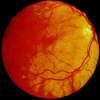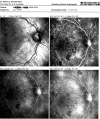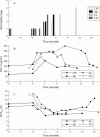Evidence that upregulation of serum IGF-1 concentration can trigger acceleration of diabetic retinopathy
- PMID: 9924360
- PMCID: PMC1722687
- DOI: 10.1136/bjo.82.7.725
Evidence that upregulation of serum IGF-1 concentration can trigger acceleration of diabetic retinopathy
Abstract
Background: Acute reduction of chronic hyperglycaemia can accelerate early diabetic retinopathy. In adolescent patients with Mauriac's syndrome, this phenomenon is related to an upregulation of subnormal serum IGF-1 levels.
Aim: To obtain longitudinal data on serum IGF-1 and retinopathy status in poorly controlled adult insulin dependent (type 1) diabetic patients without Mauriac's syndrome, in whom hyperglycaemia is reduced by intensive insulin therapy.
Methods: Four patients with chronic severe insulin deficiency and early micro-angiopathy were studied prospectively. Changes in plasma glucose, HbA1c, serum IGF-1 levels, proteinuria, retinopathy, and clinical status were followed up closely.
Results: Reducing hyperglycaemia from > 16 mmol/l (equivalent to HbA1c > 11%) to < 10 mmol/l (HbA1c < 8%) within 5 months increased serum IGF-1 levels by 70-220%. While proteinuria and symptomatic neuropathy regressed, retinopathy progressed from the mild to the severe non-proliferative stage with maculopathy (n = 4), and to the proliferative stage (n = 1). Laser coagulation was commenced upon the appearance of sight threatening macular oedema (n = 4).
Conclusion: Upregulation of serum IGF-1 preceding retinal deterioration in these patients suggests a cause-effect relation, consistent with earlier experimental and clinical data.
Figures







Comment in
-
Insulin-like growth factor type 1--friend or foe?Br J Ophthalmol. 1998 Jul;82(7):719-20. doi: 10.1136/bjo.82.7.719. Br J Ophthalmol. 1998. PMID: 9924357 Free PMC article. No abstract available.
Similar articles
-
Elevation of serum IGF-1 rather than sex steroids precedes proliferative diabetic retinopathy in Mauriac's syndrome.Horm Res. 1997;48(3):131-4. doi: 10.1159/000185502. Horm Res. 1997. PMID: 11546930
-
Progression of diabetic retinopathy during improved metabolic control may be treated with reduced insulin dosage and/or somatostatin analogue administration -- a case report.Growth Horm IGF Res. 2005 Apr;15(2):130-5. doi: 10.1016/j.ghir.2004.12.005. Growth Horm IGF Res. 2005. PMID: 15809016
-
Elevation of serum IGF-1 precedes proliferative diabetic retinopathy in Mauriac's syndrome.Br J Ophthalmol. 1997 Feb;81(2):169-70. doi: 10.1136/bjo.81.2.168b. Br J Ophthalmol. 1997. PMID: 9059256 Free PMC article. No abstract available.
-
Progression of diabetic retinopathy and changes in serum insulin-like growth factor I (IGF I) during continuous subcutaneous insulin infusion (CSII).Horm Metab Res. 1989 Jan;21(1):18-22. doi: 10.1055/s-2007-1009140. Horm Metab Res. 1989. PMID: 2925151
-
[Role of insulin-like growth factor I in the development of diabetic retinopathy].Przegl Lek. 2003;60(9):588-92. Przegl Lek. 2003. PMID: 15065339 Review. Polish.
Cited by
-
HbA1c variability is associated with an increased risk of retinopathy requiring laser treatment in type 1 diabetes.Diabetologia. 2013 Apr;56(4):737-45. doi: 10.1007/s00125-012-2816-6. Epub 2013 Jan 13. Diabetologia. 2013. PMID: 23314044
-
Early Ophthalmic Artery Blood Flow Parameter Changes in Patients with Type 1 Diabetes Mellitus.Beyoglu Eye J. 2020 Feb 14;5(1):17-21. doi: 10.14744/bej.2020.15238. eCollection 2020. Beyoglu Eye J. 2020. PMID: 35098056 Free PMC article.
-
Retinal neovascularization during treatment with IGF-1 for insulin resistance syndrome.Graefes Arch Clin Exp Ophthalmol. 2005 Jul;243(7):715-7. doi: 10.1007/s00417-004-1093-6. Epub 2005 Jan 26. Graefes Arch Clin Exp Ophthalmol. 2005. PMID: 15672252
-
Early Worsening of Retinopathy in Type 1 and Type 2 Diabetes After Rapid Improvement in Glycaemic Control: A Systematic Review.Diabetes Ther. 2022 Jan;13(1):1-23. doi: 10.1007/s13300-021-01190-z. Epub 2021 Dec 20. Diabetes Ther. 2022. PMID: 34928488 Free PMC article. Review.
-
Prevention of diabetic eye disease: the commonest cause of blindness in individuals younger than 65 years.Clin Ophthalmol. 2010 Nov 15;4:1291-8. doi: 10.2147/OPTH.S10273. Clin Ophthalmol. 2010. PMID: 21139669 Free PMC article.
References
Publication types
MeSH terms
Substances
LinkOut - more resources
Full Text Sources
Medical
Miscellaneous
